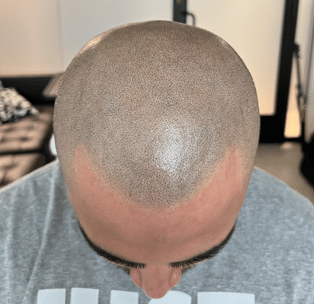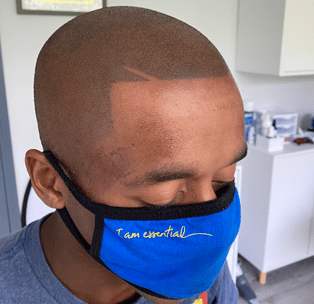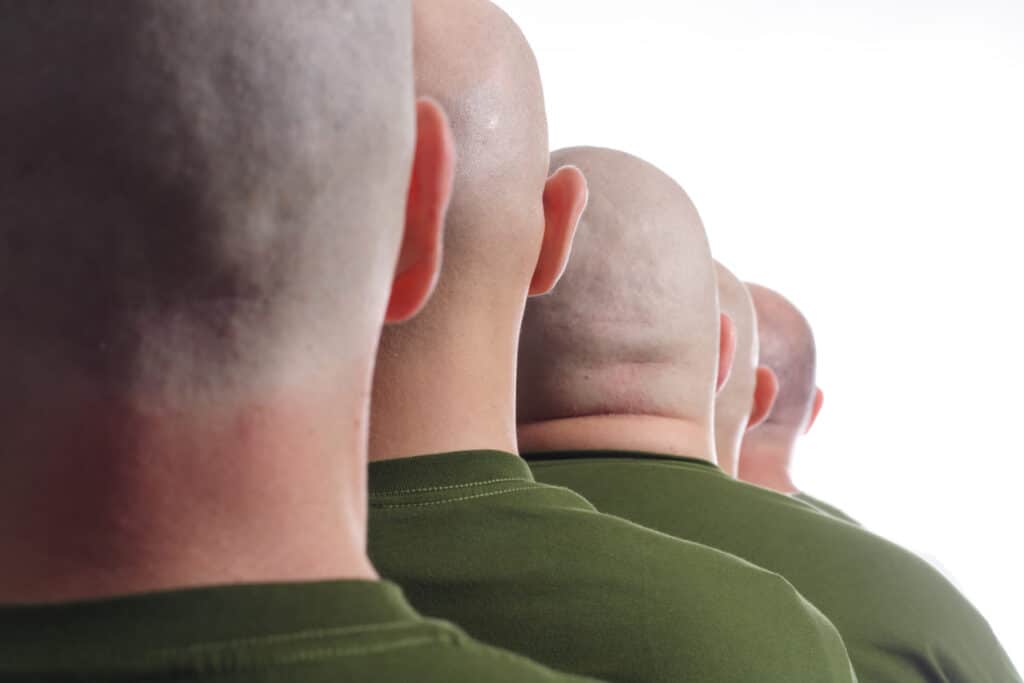For military personnel, a receding hairline can be more than a cosmetic issue; it’s a matter of maintaining both professional appearance and personal confidence within strict “high and tight” regulations. Addressing a receding hairline, especially within military haircut guidelines, presents challenges but also various solutions. Options like scalp micropigmentation (SMP), medications, hair transplants, and choosing specific hairstyles can each provide unique benefits to suit different needs and preferences.
In this blog, we’ll go over the challenges of a receding hairline within military haircut standards, explore what a receding hairline entails, including its symptoms and causes, and discuss styling options that align with military requirements. This includes an in-depth look at scalp micropigmentation treatment from Edge Scalp Ink, who’s experienced team specializes in this innovative technique and provides a practical and aesthetic solution for those in the military struggling with a receding hairline.
If you’re in the military and want to address your receding hairline with a long-term fix, contact us at Edge Scalp Ink for more information on scalp micropigmentation and don’t forget to ask about our military discount.

Military Haircut Regulations
Maintaining a neat and professional haircut in the military is more than a preference; it’s a requirement. Each branch of the military has specific regulations regarding haircuts. For men and women in the U.S. Army, for example, hairstyles must allow for the proper wearing of headgear without interference from hair length or bulk. This typically translates to short haircuts or buzz cuts for men and a tight ponytail or bun for women.
Adhering to these regulation cuts can be particularly challenging for those with receding hairlines, as finding a haircut that meets both the military’s grooming standards and personal aesthetic preferences requires careful consideration.
What Is A Receding Hairline?
A receding hairline is a common form of hair loss that’s characterized by the hairline moving backward, creating an M-shape. It’s often a sign of aging or hormonal changes. While it’s usually a gradual process, a receding hairline can significantly impact a person’s appearance and self-esteem.
To better understand a receding hairline, we’ll delve into its noticeable symptoms, such as the thinning of hair at the temples, and common causes, like genetics and lifestyle factors. This exploration will provide valuable insights into the receding hairlines and their impact on an individual.

Noticeable Symptoms
The primary indicator of a receding hairline is thinning hair along the forehead, particularly noticeable around the temples. Initially, this hair loss may be subtle, but as it progresses, the recession becomes more apparent. Over time, this can lead to increased scalp visibility, altering the way the face is framed.
This change can gradually extend, sometimes affecting the hair at the crown, leading to a more pronounced bald area. Additionally, the hairline’s movement can vary in pattern and speed, with some experiencing a more uniform recession while others may notice uneven hair loss. The texture of the remaining hair can also change, often becoming finer or different in appearance compared to other areas. This symptom is a key indicator to look out for, as early detection can lead to more effective management strategies.
Common Causes
Genetics and age are significant factors in a receding hairline, but hormonal imbalances, particularly dihydrotestosterone (DHT), also play a crucial role. Lifestyle factors like stress and diet can exacerbate hair loss, with high stress levels potentially disrupting normal hair growth cycles.
Certain hairstyles for women in the military that pull tightly on the hair, such as ponytails or braids, can lead to traction alopecia, accelerating hairline recession. Environmental elements like sun exposure and pollutants can also contribute, along with medical conditions like thyroid disorders and autoimmune diseases, which can affect hair health. Understanding these causes is vital for effective receding hairline management and treatment.
How to Style a Receding Hairline in the Military
Styling a receding hairline while adhering to military haircut regulations can be a challenge. This section explores effective strategies and treatments to manage and style a receding hairline within the military framework.
Options include SMP treatment, which is a practical and aesthetic solution, prescription medications for hair growth, hair transplant surgery for more permanent results, and selecting appropriate hairstyles that comply with military standards while minimizing the appearance of hair loss. Each option offers unique advantages and considerations for those in the military dealing with a receding hairline.
Scalp Micropigmentation (SMP) Treatment
For military personnel with receding hairlines, SMP for men involves applying natural pigments to the scalp to create the appearance of hair follicles, offering a natural, shaven look that aligns with military grooming standards. This non-invasive, quick procedure requires minimal maintenance, making it ideal for the disciplined, busy lifestyle of military personnel.
For women in the military, SMP can also address a receding hairline while adhering to strict grooming standards. SMP for women provides a natural-looking density and coverage, which is particularly beneficial for female personnel seeking a subtle yet effective approach to hair loss. This technique, tailored specifically for women, ensures a professional appearance without compromising military protocol.
Prescription Medications
Prescription medications like minoxidil or finasteride can slow hair loss and sometimes promote regrowth in cases of a receding hairline. However, they require ongoing use and may have side effects, which should be carefully considered. It’s also important to consult a healthcare provider before starting these medications to ensure they are a suitable option for your specific health status and to understand their potential impact on overall health and lifestyle.
Hair Transplant
A hair transplant is a more invasive option for addressing a receding hairline, involving the transfer of hair follicles from other body areas to the thinning scalp areas. While effective, this procedure is costly and requires a significant recovery period. Additionally, it’s important to consider that hair transplants are permanent and require careful planning to ensure a natural-looking result that aligns with future hair loss patterns.
Hairstyle Options: Regulation Cuts For a Receding Hairline
For military personnel, a regulation cut for a receding hairline is a practical and versatile option. This style involves trimming the top hair, leaving the sides tapered, and allowing as much skin as desired to be exposed. It’s a low-maintenance haircut that fits well within military guidelines and can be easily adapted to different variations, offering a balance between personal style and uniformity.
Schedule A Complimentary SMP Consultation At Edge Scalp Ink Today
Treatments like scalp micropigmentation, offered by Edge Scalp Ink, provide effective solutions for both men and women in the military who have receding hairlines. Considering SMP or other hair loss treatments can significantly help in maintaining a professional appearance in line with military standards while boosting personal confidence.
We’ve successfully treated many men and women based at Walter Reed Hospital and other bases located in the Washington, D.C. area.
For personalized advice and solutions, contact us at Edge Scalp Ink today and schedule a complimentary SMP consultation.
Military SMP FAQs
Yes, scalp micropigmentation (SMP) is typically allowed in the military. It provides a clean, shaven look that aligns with military grooming standards, making it a suitable option for personnel experiencing hair loss.
Absolutely, SMP is effective for women with a receding hairline or those who need density in the crown area. It offers a way to camouflage the hair loss and maintain a professional appearance that can comply with military requirements.
While stopping hair loss completely may not be possible, options like SMP, medication, lifestyle changes, and proper hair care can help manage and reduce the rate of hair loss. Consulting with a healthcare provider is advisable to explore suitable treatments based on the cause of your baldness.

